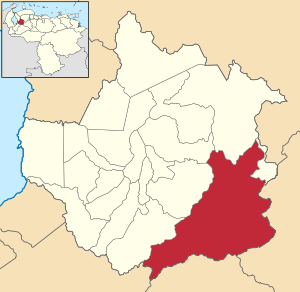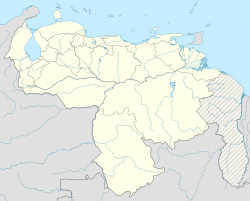Boconó facts for kids
Quick facts for kids
Boconó
|
|||
|---|---|---|---|
 |
|||
|
|||
| Nickname(s):
"Jardín de Venezuela"
(English:"Garden of Venezuela") |
|||

Boconó Municipality in Trujillo State
|
|||
| Country | Venezuela | ||
| State | Trujillo | ||
| Municipality | Boconó | ||
| Founded | 1560 | ||
| Area | |||
| • Total | 1,365 km2 (527 sq mi) | ||
| Elevation | 1,225 m (4,019 ft) | ||
| Population
(2001)
|
|||
| • Total | 79,710 | ||
| • Density | 58.40/km2 (151.3/sq mi) | ||
| • Demonym | Bocones | ||
| Time zone | UTC-4:30 (VST) | ||
| • Summer (DST) | UTC-4:30 (not observed) | ||
| Postal code |
3103
|
||
| Area code | 272 | ||
| Climate | Af | ||
| Website | [1] | ||
| Area and population figures are for the municipality | |||
Boconó is a city in the Venezuelan Andean state of Trujillo. It was founded in 1560. This city is the main town of the Boconó Municipality. In 2001, the municipality had about 79,710 people living there. Boconó is sometimes called the "Garden of Venezuela."
Contents
History of Boconó
Early Beginnings and Name Origin
The name Boconó comes from the native word Komboc. This was the name of a local river.
In 1548, a Spanish explorer named Diego Ruiz de Vallejo left El Tocuyo. He was sent to explore the Cuicas Province. This area was named after the native people who lived there. The goal was to find gold mines that were believed to be in the Boconó valley.
Control and Independence
In 1558, there was a disagreement over who controlled the Cuicas area. Francisco Ruiz, from the governor of Venezuela, wanted to claim the land. Juan de Maldonado, representing another Spanish group, said his people already controlled it. Ruiz worked hard to make sure the land stayed under Venezuela's control.
In 1786, the Boconó area was organized as the Boconó Canton. This was a way of dividing the land for easier management.
In 1811, Boconó was officially declared a city. It quickly joined the movement for independence from Spain. The Spanish Empire reacted strongly. They arrested and sent away Don Miguel Uzcátegui, who was the Mayor of Boconó.
Simón Bolívar's Visits
The famous leader Simón Bolívar visited Boconó two times. He was there from June 26 to 29, 1813, and again on March 10, 1821. During his visits, he set up a base at a place called Boca del Monte.
Bolívar stayed at the home of Mayor Jose María Baptista. He was very impressed by the region's beauty. He even called Boconó the "Garden of Venezuela."
The Battle of Niquitao
On July 2, 1813, an important battle happened near Boconó. It was called the Battle of Niquitao. This battle was part of the Admirable Campaign, a military effort for independence.
Local residents, including the Mucuchíes tribe, joined many patriots. Leaders like José Félix Ribas, Vicente Campo Elías, and Rafael Urdaneta led them. They fought against the Spanish Army, which was led by José Martí. The patriots won this important battle.
Modern Development
Over the years, Boconó's administrative structure changed. In 1864, it became the Boconó Department. Then, in 1884, it was renamed the Boconó District.
In 1955, the Boconó Airport was finished. The first planes started landing there on September 3 of that year. This helped connect Boconó to other places.
In 1990, the Boconó District became the Boconó Municipality. It was first divided into 13 smaller areas called parishes. However, one of these parishes, Campo Elías, later became its own municipality in 1995.
People of Boconó
Population Figures
The Boconó Municipality is home to many people. According to a Venezuelan count in 2001, about 79,710 people lived there. This was an increase from 70,102 people in 1990.
This population makes up about 13.1% of the total population of Trujillo state. The municipality has about 58.40 people living in each square kilometer.
See also
 In Spanish: Boconó para niños
In Spanish: Boconó para niños




